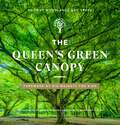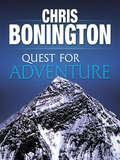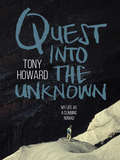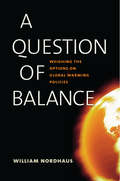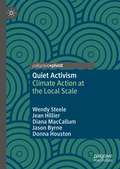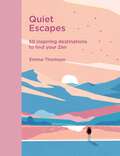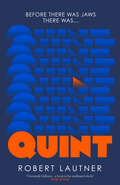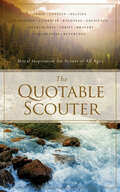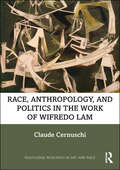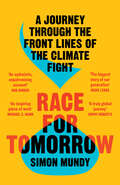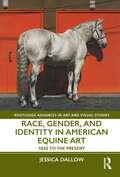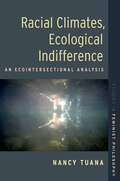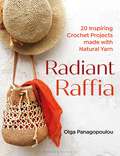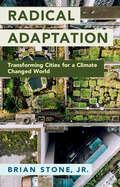- Table View
- List View
The Queen's Green Canopy: Ancient Woodlands and Trees
by Adrian Houston Charles Sainsbury-PlaiceStunning photographs of the United Kingdom's most spectacular trees - with a foreword by His Majesty the King.The Queen's Green Canopy is a beautiful photography book showcasing 70 ancient trees and 70 ancient woodlands dedicated by the QGC initiative in honour of Her Majesty's Platinum Jubilee.The book features extraordinary photographs of the United Kingdom's best-loved trees, many of which inspired historic figures, artists and writers through the centuries.Alongside these photographs are short written pieces from contributors including Dame Judi Dench, Alan Titchmarsh, Dame Joanna Lumley, Adam Henson, Archbishop Justin Welby and Danny Clarke, as well as conservation experts from the Woodland Trust and the Duchy of Cornwall. In these pieces they reflect on the trees that have made a mark on their lives and the importance of protecting Britain's woodlands for future generations.Selected trees include yews at a Cotswold's church which inspired JRR Tolkien; the apple tree believed to have inspired Sir Isaac Newton's theory of gravity; the Five Hundred Acre Wood in East Sussex immortalised in AA Milne's Winnie the Pooh books; and the 2,500-year-old tree where Henry VIII may have proposed to Anne Boleyn.So far 3 million trees have been planted by communities, schools and businesses across the country as part of the QGC initiative. Through incredible imagery and joyful pieces of writing, The Queen's Green Canopy celebrates Her Majesty's extraordinary life and the amazing legacy she leaves behind.
Quercus ilex L. ecosystems: function, dynamics and management (Advances in Vegetation Science #13)
by F. Romane J. TerradasQuest for Adventure: Remarkable feats of exploration and adventure
by Sir Chris BoningtonQuest for Adventure is a collection of stories written by Sir Chris Bonington looking at the adventurous impulse which has driven men and women to achieve the impossible in the face of Earth’s elements: crossing its oceans, deserts and poles; canoeing its rivers; climbing its mountains, and descending into its caves.Bonington selects seventeen of the most thrilling expeditions and adventures of the mid-late twentieth century, uncovering the common thread that drives men and women to achieve the impossible. Following a new preface, he charts such outstanding achievements as Thor Heyerdahl’s Kon-Tiki voyage across the Pacific Ocean; Francis Chichester’s round-the-world tour in his boat Gipsy Moth IV; the race for the first non-stop circumnavigation of the globe under sail; and Ice Bird’s sail around Antarctica.Away from the ocean, the travels of one of the world’s most outstanding desert explorers, Wilfred Thesiger, are detailed, journeying through what is menacingly called the Empty Quarter. Bonington returns to familiar ground as he writes about some exceptional mountain adventures, including the 1970 ascent of the South Face of Annapurna; Hillary and Tenzing’s first ascent of Everest; Reinhold and Gunther Messner on Nanga Parbat; Andy Cave’s triumph and tragedy on Changabang; and the Warren-Harding-led first ascent of The Nose of El Capitan in Yosemite. Wally Herbert’s team crossing of the Arctic Ocean and the equally gruelling Fuchs/Hillary crossing of Antarctica are written about in detail.More recent adventures include the race to make the first circumnavigation of the globe by balloon – a high-stakes race with a high-profile cast, including Richard Branson and Steve Fossett. Quest for Adventure concludes with an account of the cave diving epic the Dead Man’s Handshake, leaving the reader with a chill in their spine and an appreciation for the natural wonders below the Earth’s surface.Bonington’s eloquent writing on a subject in which he is a passionate authority makes for a highly engrossing read for adventurers and armchair explorers alike.
The Quest for the Sustainable Development Goals: Living experiences in territorializing the 2030 Agenda in Brazil (Sustainable Development Goals Series)
by Thiago Gehre Galvao Henrique Zeferino de MenezesThe book presents the experiences, complexities, and contradictions of the implementation of the Sustainable Development Goals in Brazil so far. Through chapters from a variety of stakeholders, the book examines national, regional, and local aspects of development in Brazil. The chapters here draw from scientific knowledge and practical experience to take a critical look at what the SDGs mean in a Global South country and what the implications of this are for global development. The book is divided into three sections. The first section addresses the critical political and institutional aspects related to the implementation of the Sustainable Development Goals in Brazil, highlighting advances as well as pitfalls and setbacks. The chapters look at broad questions related to the role of civil society in defining political priorities and strategies to move forward with the SDGs as well as issues involved in incorporating the SDGs at different levels of government and other institutions. The chapters in this section critically address the political and institutional advances as well as barriers to the progress of the SDGs in Brazil. The second section directly addresses progress made toward the SDGs in the context of the political, economic and social variables specific to Brazil. The chapters address critical shortcomings and demands for Brazilian society: the need for improvements in education and employment policies to reduce poverty, the urgent need to increase gender equality and reduce violence, as well as the imperative to strengthen institutions and policies to mitigate climate change and protect the environment. The final section focuses on critically assessing the 2030 Agenda itself and drawing from a Global South IR perspective. The chapters here dialog with decolonial and post-developmentalist perspectives to highlight problems with the agenda and lift up sidelined priorities, presenting yet-unexamined policy solutions and innovations that are currently absent from the global institutional agenda. The Brazilian case is a perfect illustration of how underdevelopment and political instability can constrain the paths to sustainable development, while at the same time social innovations, leverages based on regional dynamics, and strength from social and cultural diversity can drive sustained progress.
Quest into the Unknown: My life as a climbing nomad
by Tony HowardWe are all climbing where we are and with the gear we use in no small part due to Tony Howard’s quest for adventure.Tony Howard rose to fame in 1965 as a member of a group of young climbers from northern England who made the first British ascent of Norway’s Troll Wall; a climb described by Joe Brown as, ‘One of the greatest ever achievements by British rock climbers’. Tony went on to design the modern sit harness, now used worldwide by most climbers. He founded the company Troll Climbing Equipment but never stopped exploring. Quest into the Unknown is his story.Tony has dedicated his life to travelling the world in search of unclimbed rock faces and remote trekking adventures. The scale of his travels is vast: he has visited all of the North African countries, much of the Arab land of the Middle East, the mountainous regions of Scandinavia, Canada and the rocky spine of the Americas, the Himalaya, remote Indian provinces, South East Asia, Madagascar, South Georgia and Antarctica. This book, the last word in adventure travel, takes the reader from Tony’s youth spent developing the crags of the English Peak District, via whaling ships in the Southern Ocean, thousand-mile canoe trips in the Canadian Arctic, living amongst the Bedouin in the rocky mountains of Jordan, to the isolated opium tribes of Thailand.Tony Howard’s Quest into the Unknown is the jaw-dropping account of a life of adventure that is the very definition of true exploration.
A Question of Balance: Weighing the Options on Global Warming Policies
by Prof. William D. NordhausAs scientific and observational evidence on global warming piles up every day, questions of economic policy in this central environmental topic have taken center stage. But as author and prominent Yale economist William Nordhaus observes, the issues involved in understanding global warming and slowing its harmful effects are complex and cross disciplinary boundaries. For example, ecologists see global warming as a threat to ecosystems, utilities as a debit to their balance sheets, and farmers as a hazard to their livelihoods. In this important work, William Nordhaus integrates the entire spectrum of economic and scientific research to weigh the costs of reducing emissions against the benefits of reducing the long-run damages from global warming. The book offers one of the most extensive analyses of the economic and environmental dynamics of greenhouse-gas emissions and climate change and provides the tools to evaluate alternative approaches to slowing global warming. The author emphasizes the need to establish effective mechanisms, such as carbon taxes, to harness markets and harmonize the efforts of different countries. This book not only will shape discussion of one the world’s most pressing problems but will provide the rationales and methods for achieving widespread agreement on our next best move in alleviating global warming.
The Quick Guide to Wild Edible Plants: Easy to Pick, Easy to Prepare
by Lytton John Musselman Harold J. WigginsA recent rise in the popularity of urban farming, farmers’ markets, and foraging from nature means more people are looking for information about plants. In The Quick Guide to Wild Edible Plants, botanists Lytton John Musselman and Harold J. Wiggins coach you on how to safely identify, gather, and prepare delicious dishes from readily available plants—and clearly indicate which ones to avoid.More than 200 color illustrations, accompanied by detailed descriptions, will help you recognize edible plants such as nettles, daylilies, river oats, and tearthumbs. For decades, Musselman and Wiggins have taught courses on how to prepare local plants, and their field-to-table recipes require only a few, easily found ingredients. They offer instructions for making garlic powder out of field garlic and turning acorns into flour for Rappahannock Acorn Cakes. To toast your new skill, they even include recipes for cordials. The Quick Guide to Wild Edible Plants is a great gift for the beginning naturalist and the perfect addition to every serious forager’s library.
Quiet Activism: Climate Action at the Local Scale
by Wendy Steele Jean Hillier Diana MacCallum Jason Byrne Donna HoustonThis book focuses on the potential and possibilities for socially innovative responses to the climate emergency at the local scale. Climate change has intensified the need for communities to find creative and meaningful ways to address the sustainability of their environments. The authors focus on the creative and collaborative ways local- scale climate action reflects the extra-ordinary measures taken by ordinary people. This includes critical engagement with the ways in which novel social practices and partnerships emerge between people, organisations, institutions, governance arrangements and eco-systems. The book successfully highlights the transformative power of socially innovative activities and initiatives in response to the climate crisis; and critically explores how different individuals and groups undertake climate action as ‘quiet activism’ – the embodied acts of collective disruption, subversion, creativity and care at the local scale.
Quiet Escapes: 50 inspiring destinations to find your Zen
by Emma ThomsonDiscover the world's most peaceful destinations.In Quiet Escapes, award-winning travel writer Emma Thomson curates 50 inspirational trips from across the globe, each carefully selected to help you find your Zen. Including a host of natural wilderness adventures, remote island retreats, sacred pilgrim routes and unexpected oases of quiet in urban areas, this definitive guide equips you with the very best places to unwind and enjoy some true quiet reflection.From stargazing in New Zealand to feeding mind, body and soul in Bali, an art safari in Zambia to a quiet city break in Switzerland, you will be spoilt for choice when planning your next calming escape.
The Quiet Moon: Pathways to an Ancient Way of Being
by Kevin ParrThe ancient Celts lived by and worshipped the moon. While modern, digital life is often at odds with nature – rubbing against it rather than working in harmony with it – is there something to be said for embracing this ancient way of being and reconnecting to the moon’s natural calendar?January’s Quiet Moon reflects an air of melancholy, illuminating a midwinter of quiet menace; it was the time of the Dark Days for the ancient Celts, when the natural world balanced on a knife edge. By May, the Bright Moon brings happiness as time slows, mayflies cloud and elderflowers cascade. Nature approaches her peak during a summer of short nights and bright days – this was when the ancient Celts claimed their wives and celebrated Lugnasad. With the descent into winter comes the sadness of December’s Cold Moon. Trees stand bare and creatures shiver their way to shelter as the Dark Days creep in once more and the cycle restarts. In The Quiet Moon, Kevin Parr discovers that a year of moons has much to teach us about how to live in the world that surrounds us – and how being more in tune to the rhythms of nature, even in the cold and dark, can help ease the suffering mind.
Quint
by Robert Lautner'Uncannily brilliant… a book to be swallowed whole' EVIE WYLD Before there was Jaws, there was… QUINT
The Quotable Scouter: Moral Inspiration for Scouts of All Ages
by Edith SongerThe Quotable Scouter communicates the values that have been upheld by the scouting movement ever since Robert Baden-Powell published Scouting for Boys in 1908. These values, so critical to our nation and world, are worth exploring repeatedly as we work to develop strong character in ourselves and the young people we serve.
Rabbits: The Animal Answer Guide (The Animal Answer Guides: Q&A for the Curious Naturalist)
by John Seidensticker Susan LumpkinDid you know that there are more than 90 species of rabbits, hares, and pikas, rabbits' little-known cousins? And that new species are still being found? Or that baby rabbits nurse from their mothers only once a day? How about that some people brew medicinal tea from rabbit pellets? Wildlife conservationists Susan Lumpkin and John Seidensticker have all the answers—from the mundane to the unbelievable—about the world’s leaping lagomorphs. To some, rabbits are simply a docile pet for the classroom or home. To others, they are the cute animals munching on clover or the pests plaguing vegetable gardens. Whatever your interest, in Rabbits: The Animal Answer Guide you will discover that they are a more complex group than you might have first imagined. Lumpkin and Seidensticker take these floppy-eared creatures out of the cabbage patch and into the wild, answering 95 frequently asked questions about these familiar and fascinating animals.With informative photographs and an accessible format, Rabbits: The Animal Answer Guide is the one resource you will need to learn about rabbits' anatomy and physiology, evolutionary history, ecology, behavior, and their relationships with humans. Lumpkin and Seidensticker also talk about conservation, because while rabbits may breed like, well, rabbits, several species are among the most endangered animals on Earth.
Race, Anthropology, and Politics in the Work of Wifredo Lam (Routledge Research in Art and Race)
by Claude CernuschiThis book reinterprets Wifredo Lam’s work with particular attention to its political implications, focusing on how these implications emerge from the artist’s critical engagement with 20th-century anthropology. Field work conducted in Cuba, including the witnessing of actual Afro-Cuban religious ritual ceremonies and information collected from informants, enhances the interpretive background against which we can construe the meanings of Lam's art. In the process, Claude Cernuschi argues that Lam hoped to fashion a new hybrid style to foster pride and dignity in the Afro-Cuban community, as well as counteract the acute racism of Cuban culture.
Race, Anthropology, and Politics in the Work of Wifredo Lam (Routledge Research in Art and Race)
by Claude CernuschiThis book reinterprets Wifredo Lam’s work with particular attention to its political implications, focusing on how these implications emerge from the artist’s critical engagement with 20th-century anthropology. Field work conducted in Cuba, including the witnessing of actual Afro-Cuban religious ritual ceremonies and information collected from informants, enhances the interpretive background against which we can construe the meanings of Lam's art. In the process, Claude Cernuschi argues that Lam hoped to fashion a new hybrid style to foster pride and dignity in the Afro-Cuban community, as well as counteract the acute racism of Cuban culture.
Race for the Ruby Turtle
by Stephen BramucciA heartfelt middle grade eco-adventure story full of friendship and self-discovery, perfect for fans of Dan Gemeinhart and Gary D. Schmidt.Jake Rizzi is about to spend the summer at his great-aunt's cabin in the mossy, sodden Oregon backwoods. His parents seem to need a break from him and his ADHD. He tries not to take it personally, but isn't sure about his aunt's off-the-grid lifestyle and strange stories about a turtle with a ruby-colored shell.Soon, Jake learns that the turtle is more than a myth. And thanks to a viral article online, strangers from all over the world have arrived to search for it--including a sinister animal poacher and towering twin zoologists from Sweden. Jake is sure that finding the turtle will change how people see him and his “attention issues”--but he'll need help. Setting off with his new friend Mia, Jake must decide what matters more--personal glory? Or protecting the wonders of nature?
Race for Tomorrow: Survival, Innovation And Profit On The Front Lines Of The Climate Crisis
by Simon MundyAs heard on BBC Radio 4’s Start the Week with Andrew Marr ‘Vivid and informed … Don’t wait. Read it now’ ADAM NICOLSON ‘Brilliant … An optimistic, unpatronising account of what humankind CAN do’ ROB RINDER
Race, Gender, and Identity in American Equine Art: 1832 to the Present (Routledge Advances in Art and Visual Studies)
by Jessica DallowThis book traces an evolution of equine and equestrian art in the United States over the last two centuries to counter conventional understandings of subjects that are deeply enmeshed in the traditions of elite English and European culture. In focusing on the construction of identity in painting and photography—of Blacks, women, and the animals themselves involved in horseracing, rodeo, and horse show competition—it illuminates the strategic and varying roles visual artists have played in producing cultural understandings of human-animal relationships. As the first book to offer a history of American equine and equestrian imagery, it shrinks the chasm of literature on the subject and illustrates the significance of the genre to the history of American art. This book further connects American equine and equestrian art to historical, theoretical, and philosophical analyses of animals and attests to how the horse endures as a vital, meaningful subject within the art world as well as culture at large. This book will be of interest to scholars in art history, American art, gender studies, race and ethnic studies, and animal studies.
Race, Gender, and Identity in American Equine Art: 1832 to the Present (Routledge Advances in Art and Visual Studies)
by Jessica DallowThis book traces an evolution of equine and equestrian art in the United States over the last two centuries to counter conventional understandings of subjects that are deeply enmeshed in the traditions of elite English and European culture. In focusing on the construction of identity in painting and photography—of Blacks, women, and the animals themselves involved in horseracing, rodeo, and horse show competition—it illuminates the strategic and varying roles visual artists have played in producing cultural understandings of human-animal relationships. As the first book to offer a history of American equine and equestrian imagery, it shrinks the chasm of literature on the subject and illustrates the significance of the genre to the history of American art. This book further connects American equine and equestrian art to historical, theoretical, and philosophical analyses of animals and attests to how the horse endures as a vital, meaningful subject within the art world as well as culture at large. This book will be of interest to scholars in art history, American art, gender studies, race and ethnic studies, and animal studies.
Racial Climates, Ecological Indifference: An Ecointersectional Analysis (STUDIES IN FEMINIST PHILOSOPHY SERIES)
by Nancy TuanaWhile the heavy social impacts of raging wildfires, punishing storms, and climbing temperatures worldwide have made many increasingly aware of the need for climate justice, the intersection of race and climate change has too often been neglected in the literature and in practice. In Racial Climates, Ecological Indifference, author Nancy Tuana urges that engagement with histories and lineages of ecological indifference and systemic racisms leads to a more robust understanding of the nature of climate injustices. Applying her "ecointersectional" framework, Tuana reveals how racist institutions and practices often fuel environmental destruction and contribute to climate change. Building on the work of Black feminist theorists, she demonstrates that the basic social structures that generate environmental destruction are the same as those that generate systemic oppression, making clear that the more traditional focus on the differential distribution of harms and benefits of climate change, while important, constitutes only one dimension of climate injustice due to systemic racisms. This book provides a more adequate account of racial climates by disclosing the additional dimensions of climate injustice. Ultimately, Tuana underscores that any effort to protect the environment must also be a fight against systemic racisms and other forms of systemic inequity.
Racial Climates, Ecological Indifference: An Ecointersectional Analysis (STUDIES IN FEMINIST PHILOSOPHY SERIES)
by Nancy TuanaWhile the heavy social impacts of raging wildfires, punishing storms, and climbing temperatures worldwide have made many increasingly aware of the need for climate justice, the intersection of race and climate change has too often been neglected in the literature and in practice. In Racial Climates, Ecological Indifference, author Nancy Tuana urges that engagement with histories and lineages of ecological indifference and systemic racisms leads to a more robust understanding of the nature of climate injustices. Applying her "ecointersectional" framework, Tuana reveals how racist institutions and practices often fuel environmental destruction and contribute to climate change. Building on the work of Black feminist theorists, she demonstrates that the basic social structures that generate environmental destruction are the same as those that generate systemic oppression, making clear that the more traditional focus on the differential distribution of harms and benefits of climate change, while important, constitutes only one dimension of climate injustice due to systemic racisms. This book provides a more adequate account of racial climates by disclosing the additional dimensions of climate injustice. Ultimately, Tuana underscores that any effort to protect the environment must also be a fight against systemic racisms and other forms of systemic inequity.
Radiant Raffia: 20 Inspiring Crochet Projects Made With Natural Yarn
by Olga PanagopoulouLearn how to crochet 20 beautiful objects in raffia from bags, hats and belts to cushions, vases and table decorations.Get your hooks ready for a crochet book which brings the warmth of summer all year round. Patterns, charts and stunning photography are intertwined to create an inspiring atmosphere where the land, sea, textures and colours of the Greek islands work in harmony with the materials and techniques. Through step-by-step instructions discover 20 beautiful projects which show you how you can make stylish items which are 100% plant-based and eco-friendly. Mindful and relaxing, enjoy crocheting with raffia to create lovely gifts for friends and family or fashionable summer-inspired pieces to keep for yourself. Radiant Raffia is the essential modern guide to this must-have accessory.
Radiant Raffia: 20 Inspiring Crochet Projects Made With Natural Yarn
by Olga PanagopoulouLearn how to crochet 20 beautiful objects in raffia from bags, hats and belts to cushions, vases and table decorations.Get your hooks ready for a crochet book which brings the warmth of summer all year round. Patterns, charts and stunning photography are intertwined to create an inspiring atmosphere where the land, sea, textures and colours of the Greek islands work in harmony with the materials and techniques. Through step-by-step instructions discover 20 beautiful projects which show you how you can make stylish items which are 100% plant-based and eco-friendly. Mindful and relaxing, enjoy crocheting with raffia to create lovely gifts for friends and family or fashionable summer-inspired pieces to keep for yourself. Radiant Raffia is the essential modern guide to this must-have accessory.
Radiation and Environmental Safety in North-West Russia: Use of Impact Assessments and Risk Estimation (Nato Security through Science Series B:)
by Per Strand Malgorzata K. Sneve Andrey V. PechkurovThis book provides a study of radiation and environmental safety in north-west Russia. International experts from several related fields offer a thorough understanding of the present status. They suggest how to develop the use of overall risk assessments and environmental impact assessments to ensure a sound use of resources when carrying out the tremendous work that must be carried out to clean up the cold war legacy.
Radical Adaptation: Transforming Cities for a Climate Changed World
by null Brian Stone, Jr.This book considers the everyday conduits through which climate instability is revealing itself: the storm sewer drain on your street, the powerlines transporting your electricity, the mix of vegetation in your backyard or neighborhood park – these are the pathways through which climate change is most likely to impact your life. For many, these are the last places we expect it to. The first book to establish a framework for climate change adaptation, Stone's aim is to understand how climate change is altering our lives in the present period – this period of transition between the ancient, stable climate of our ancestors and the unfolding, no longer stable climate of our children – and how our cities might adapt to these changes. Stone's concern is with the risks posed by a new environmental regime for which our modes of living are ill-adapted, and with how these modes of living must be altered – radically altered – to persist in a climate changed world.
